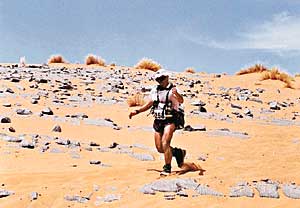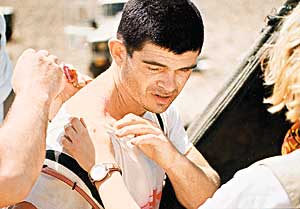My duel with the desert
By Mark Sharp
The annual Marathon Des Sables (MDS) is an undertaking beyond the realms of the normal 42 kilometre standard athletic marathon distance. It is a distance that can be six times longer but normally averages about 230 kilometres. This year's event attracted just over 620 competitors and can you believe there was actually a waiting list?!
 "See ya at the finish!": A confident Mark Sharp indicates all's well during the middle of the run |
 Water babies: Rachel Chiu and Mandy Lo stock up on provisions |
Day 2 - the desert had started to take its toll and 620 people were beginning to wonder what on earth they'd let themselves in for.
Times for completing each stage were ranging from two hours to eight-hours plus. This included the blind and physically handicapped. It was becoming a race of a different nature. People were here to finish, they were here to learn about themselves. The MDS is something that even the top runners know is a gamble as the desert has many faces which can crush even the most experienced. It becomes apparent very quickly that this is not a race that tolerates arrogance.
Day 3, 37 kilometres and people were breaking down.
Times were getting slower and competitors were still coming into the campsite after dark after the usual 9 am starts . The medical tent looked like a battlefield.
 Yowch!: Chafed backs and blisters abound |
Day 6 and the campsite was abuzz with confidence. It was the marathon stage, 42 kilometres total distance, 15 of which covered some of the biggest dunes in Africa. It was a day of hardship for all involved with some competitors taking 12-plus hours to complete this penultimate stage. But crossing the line that day, they triumphed for whatever personal reasons they had.
The final day, Day 7, dawned with a 9.5 kilometre run into the desert town centre of Erfoud. The pace was naturally furious to the finish line. On crossing it there was an incredible feeling of catharsis and relief. Tears flowed freely. This is something that only you can experience for yourself. They call it "the spirit of the MDS".
<< Back to Index >>